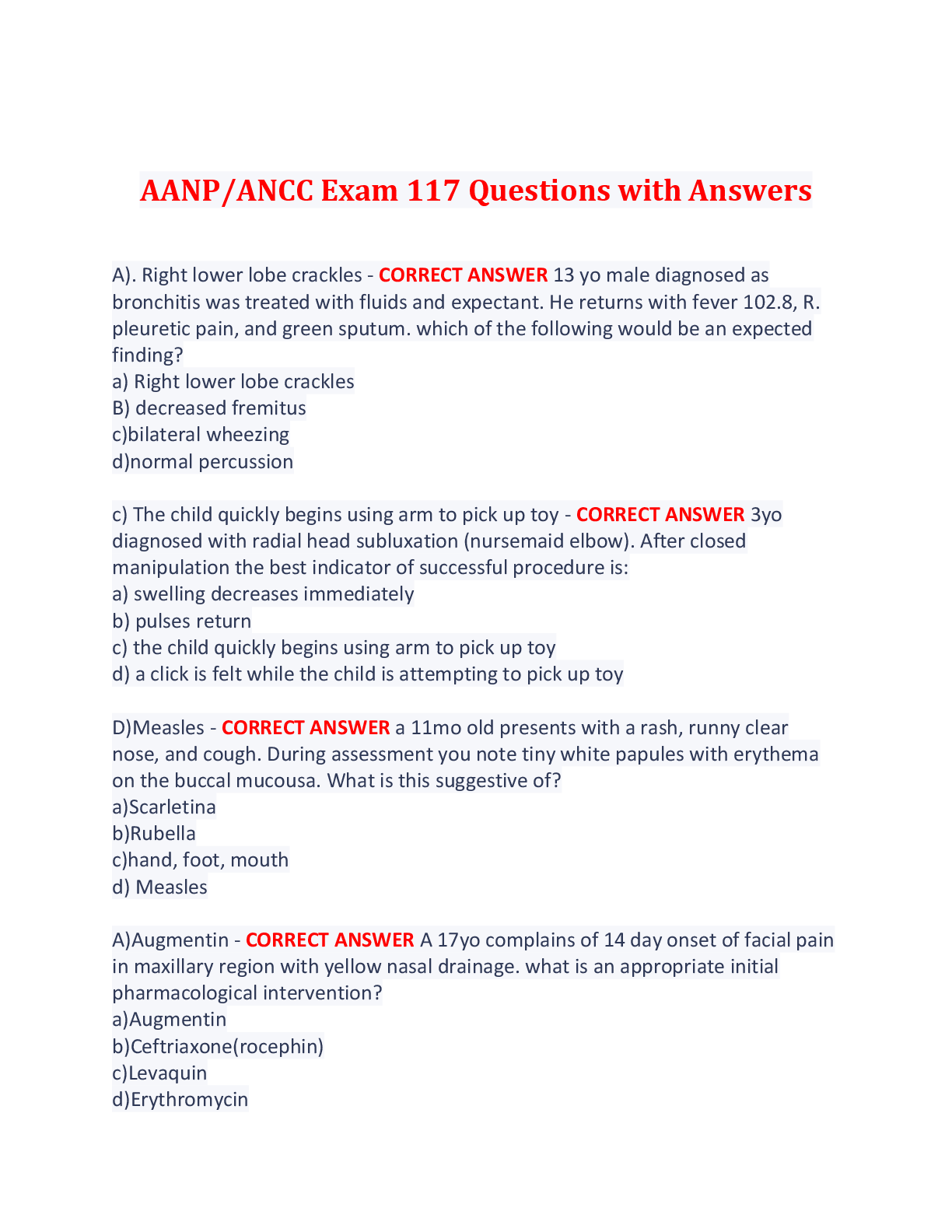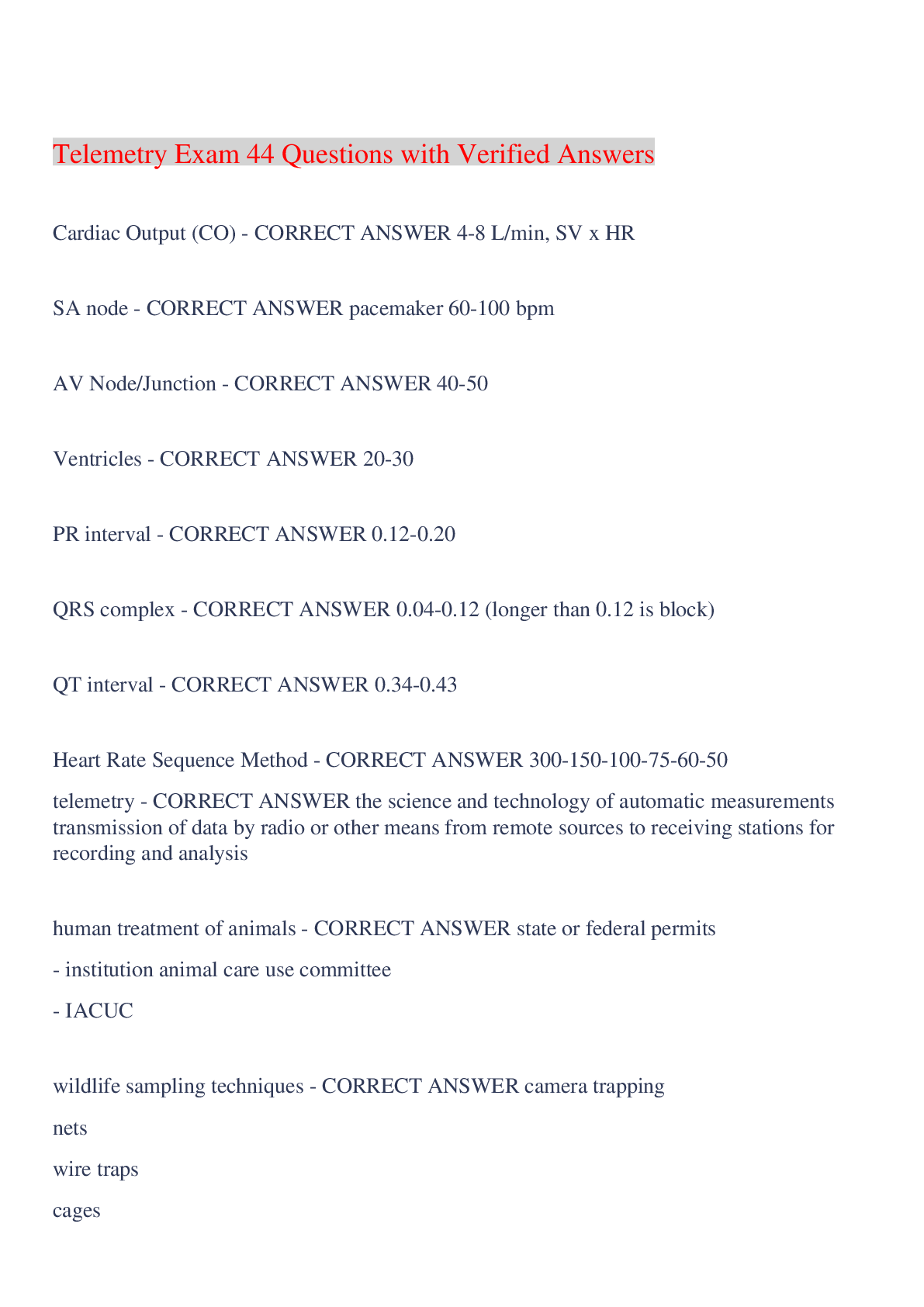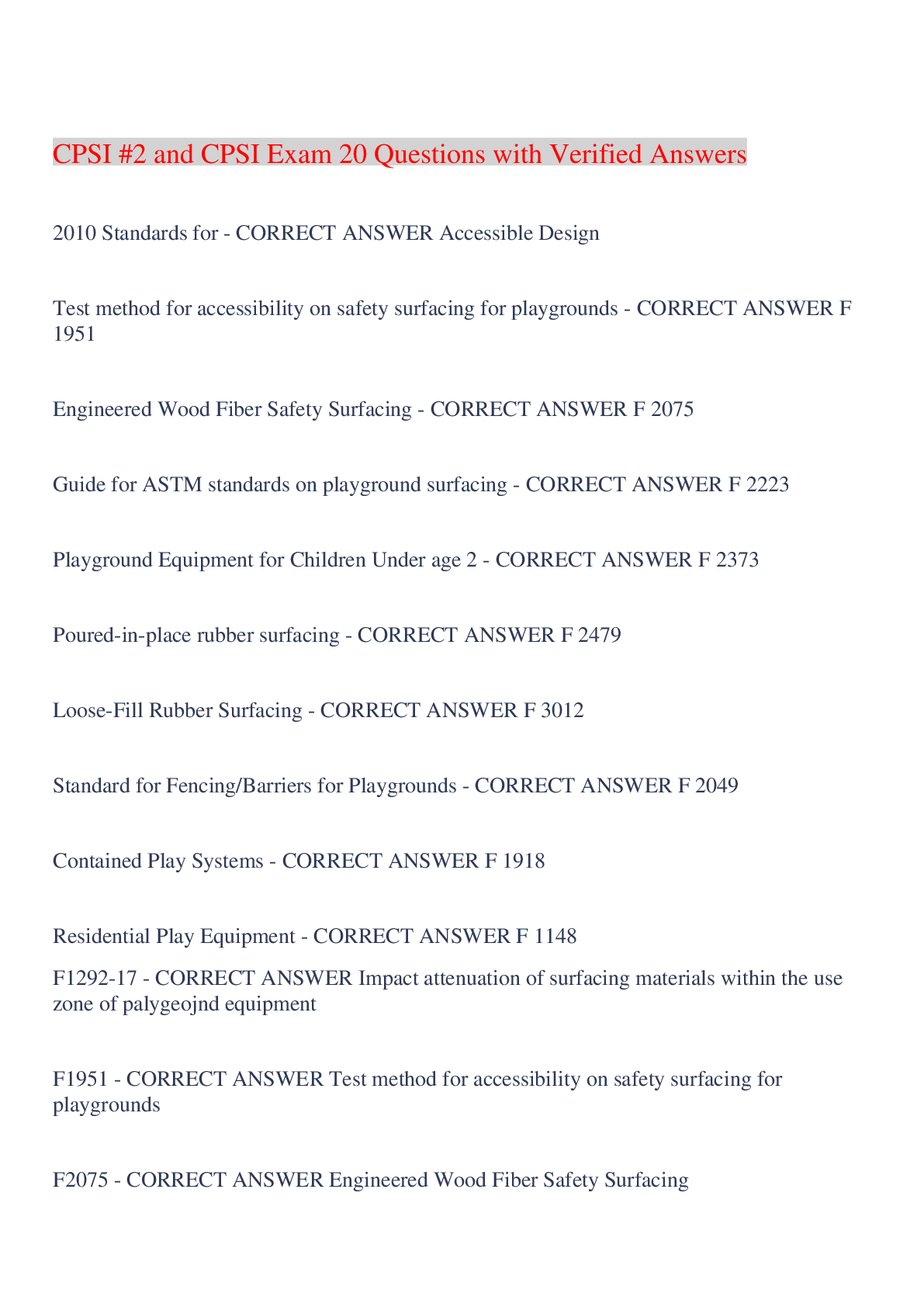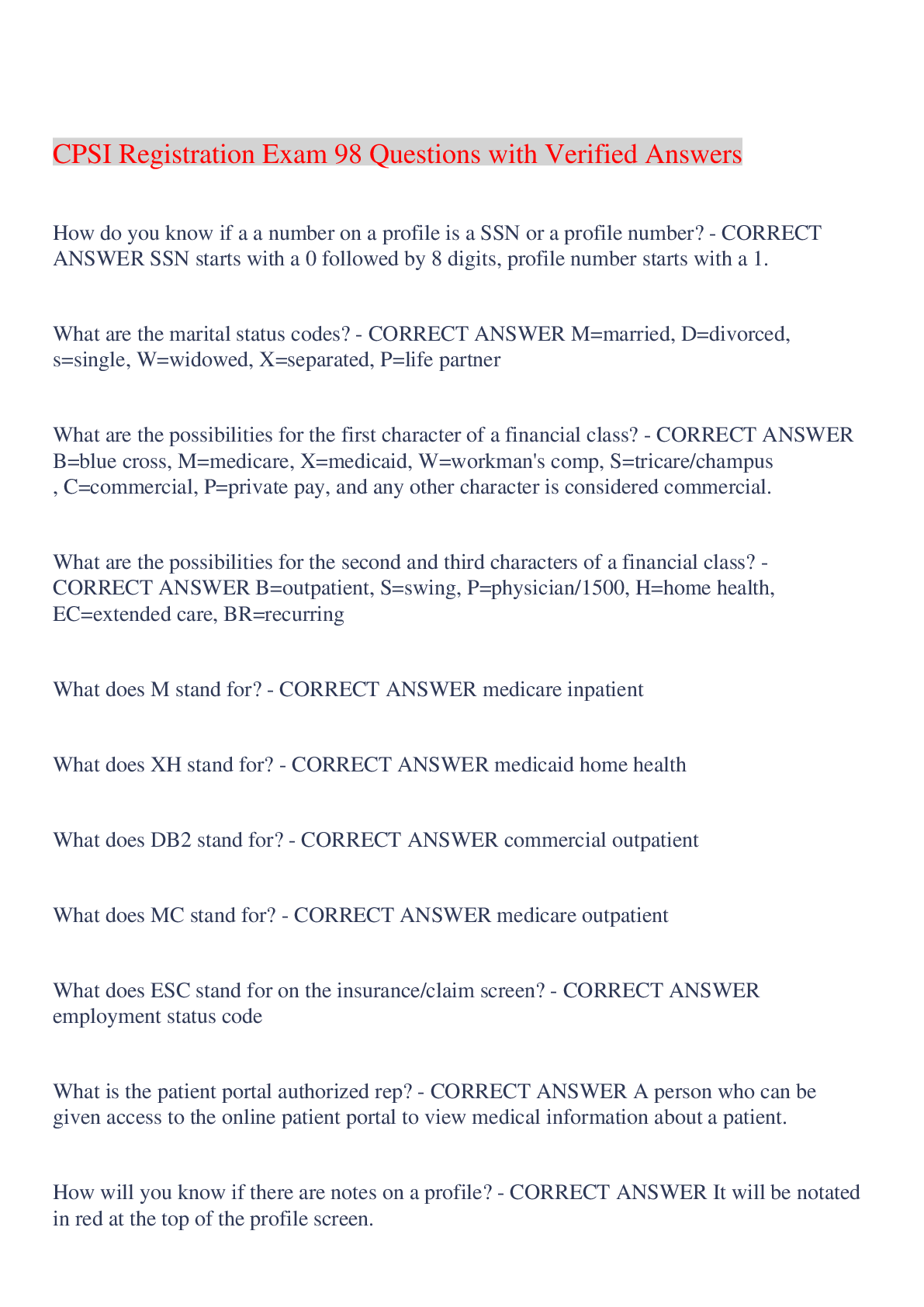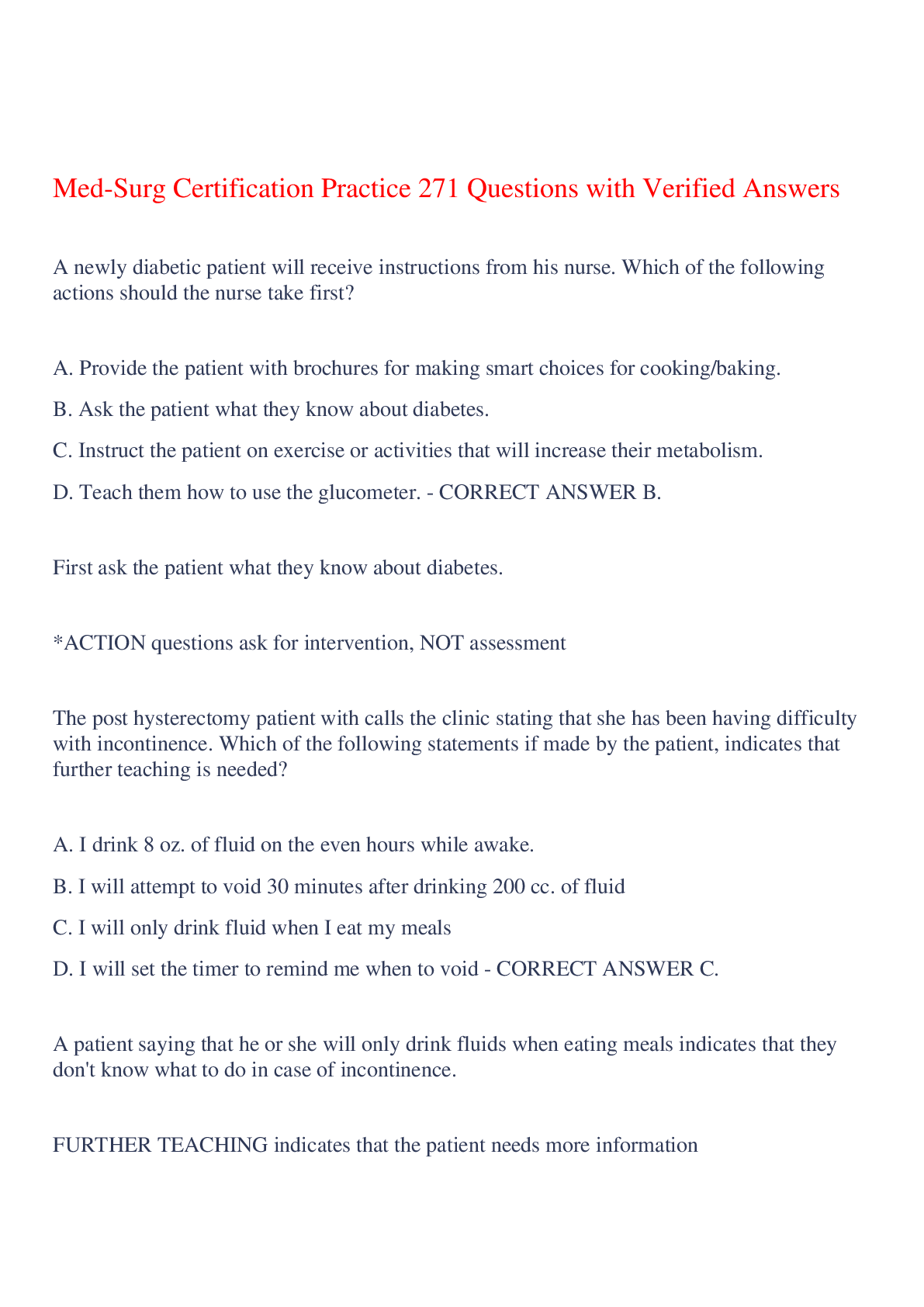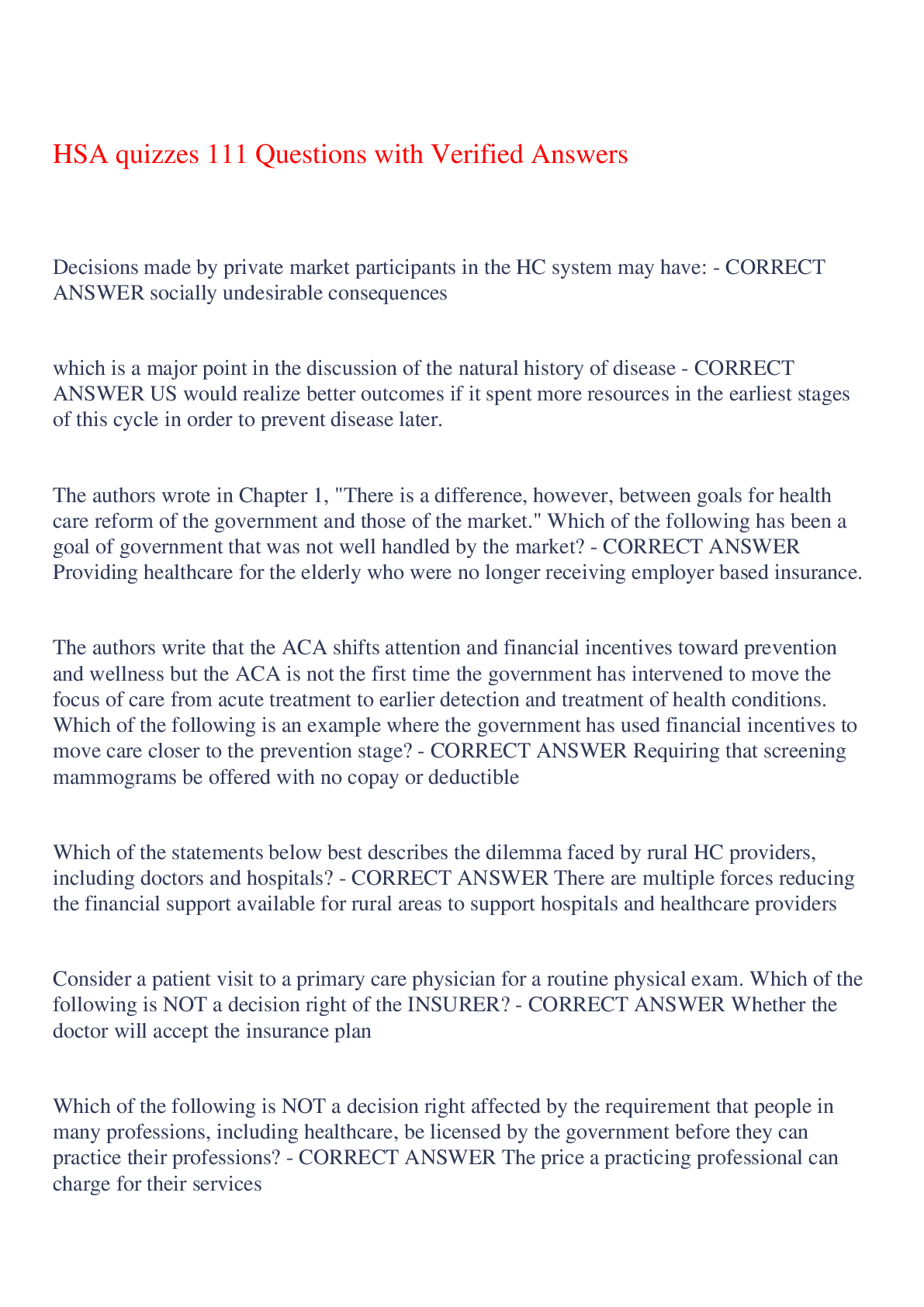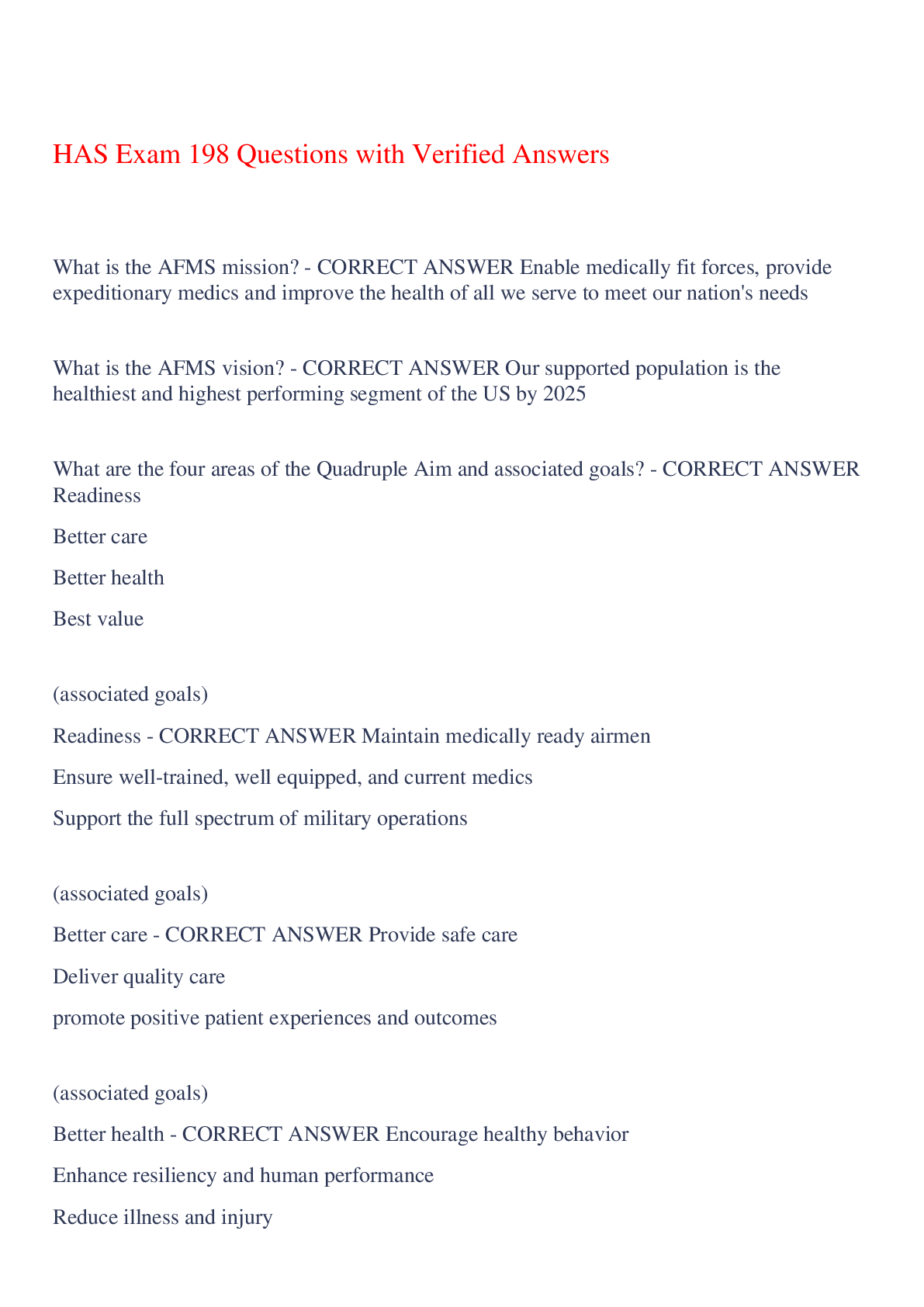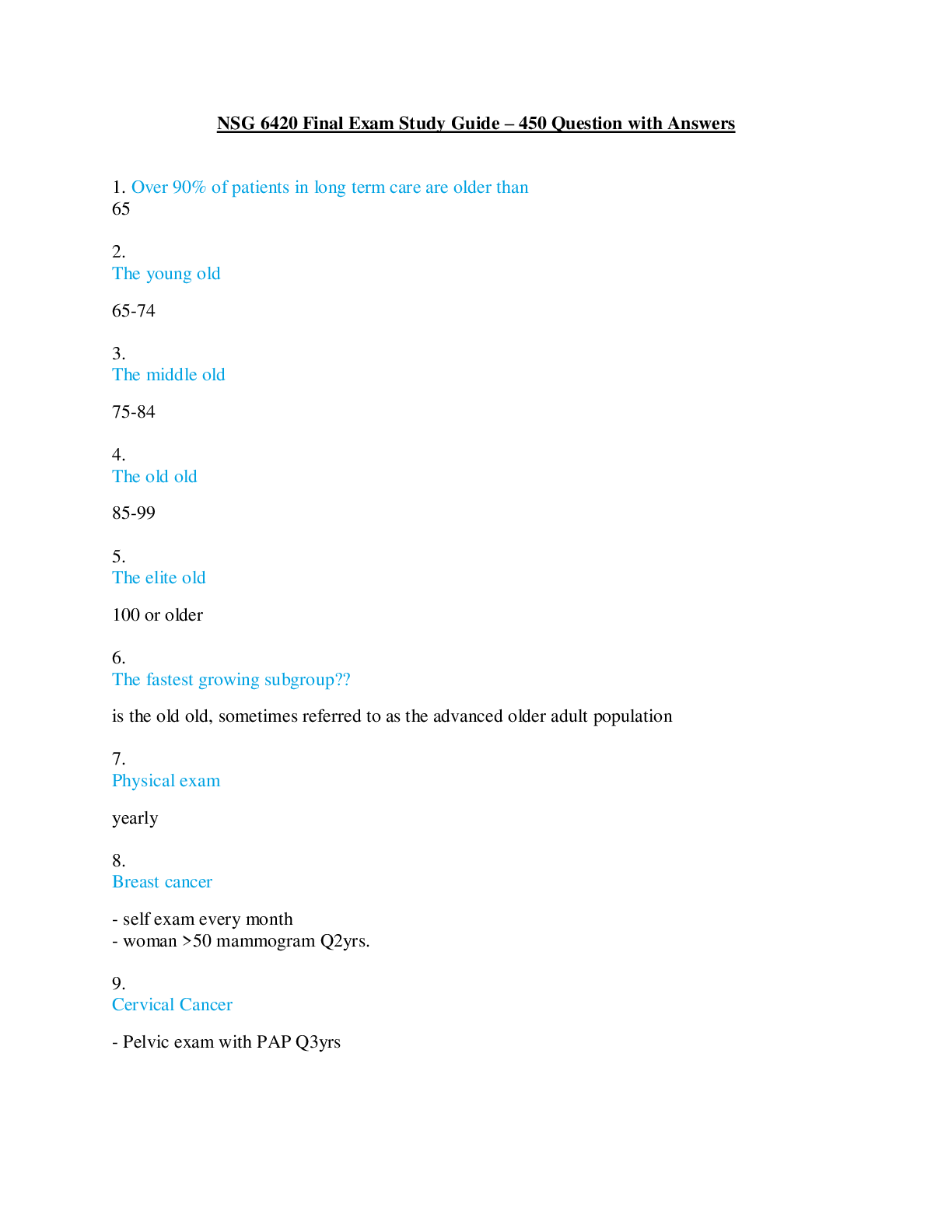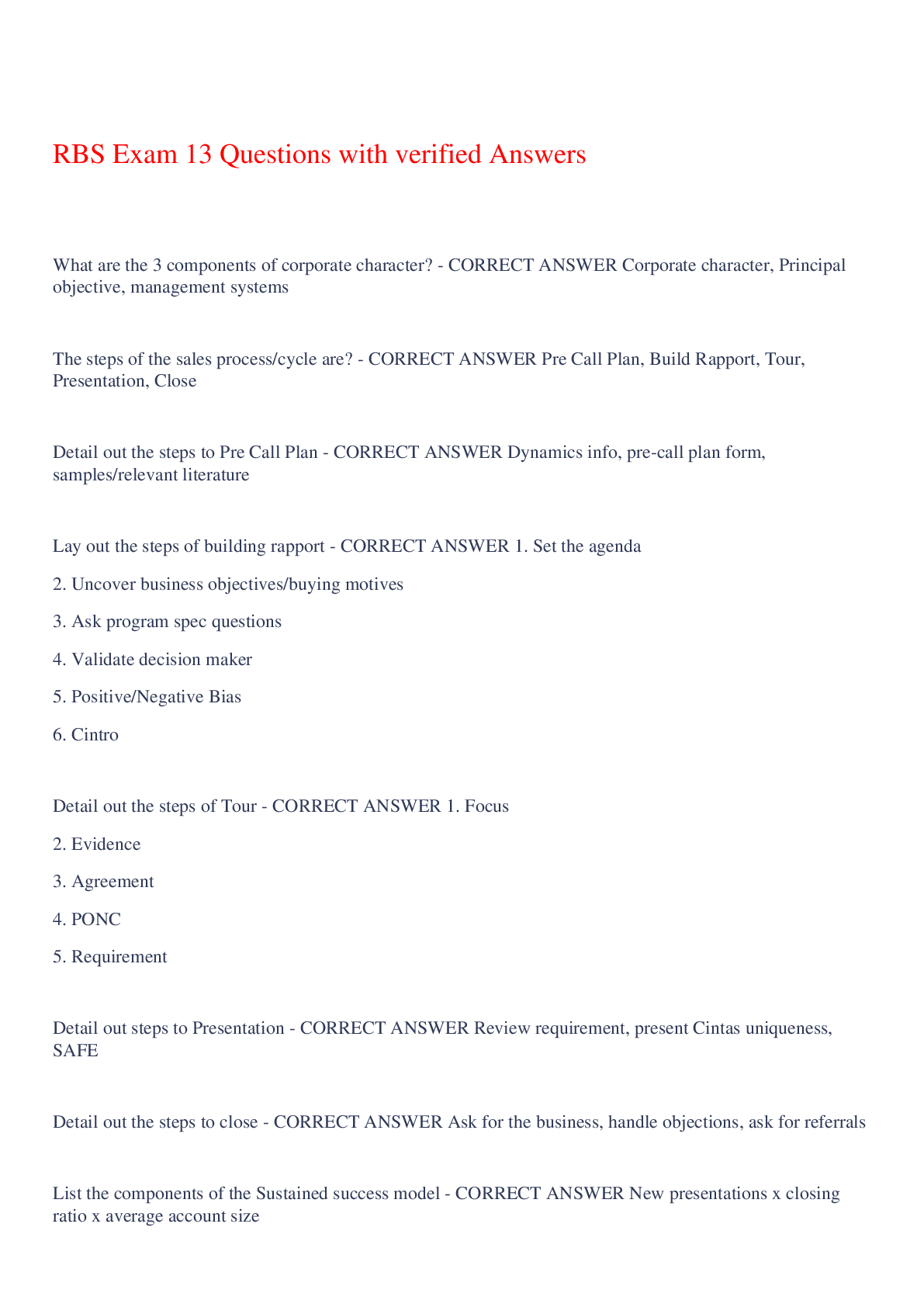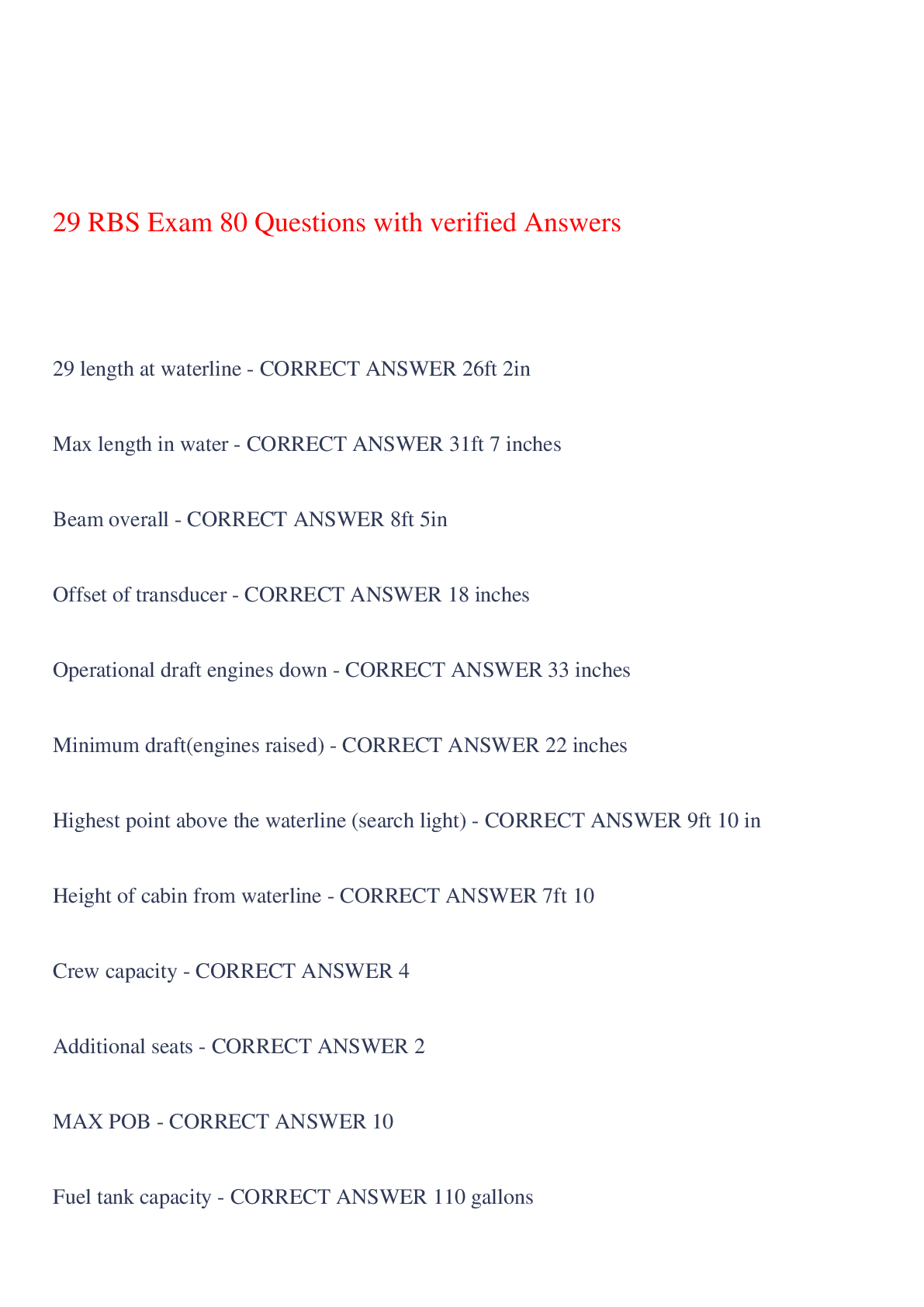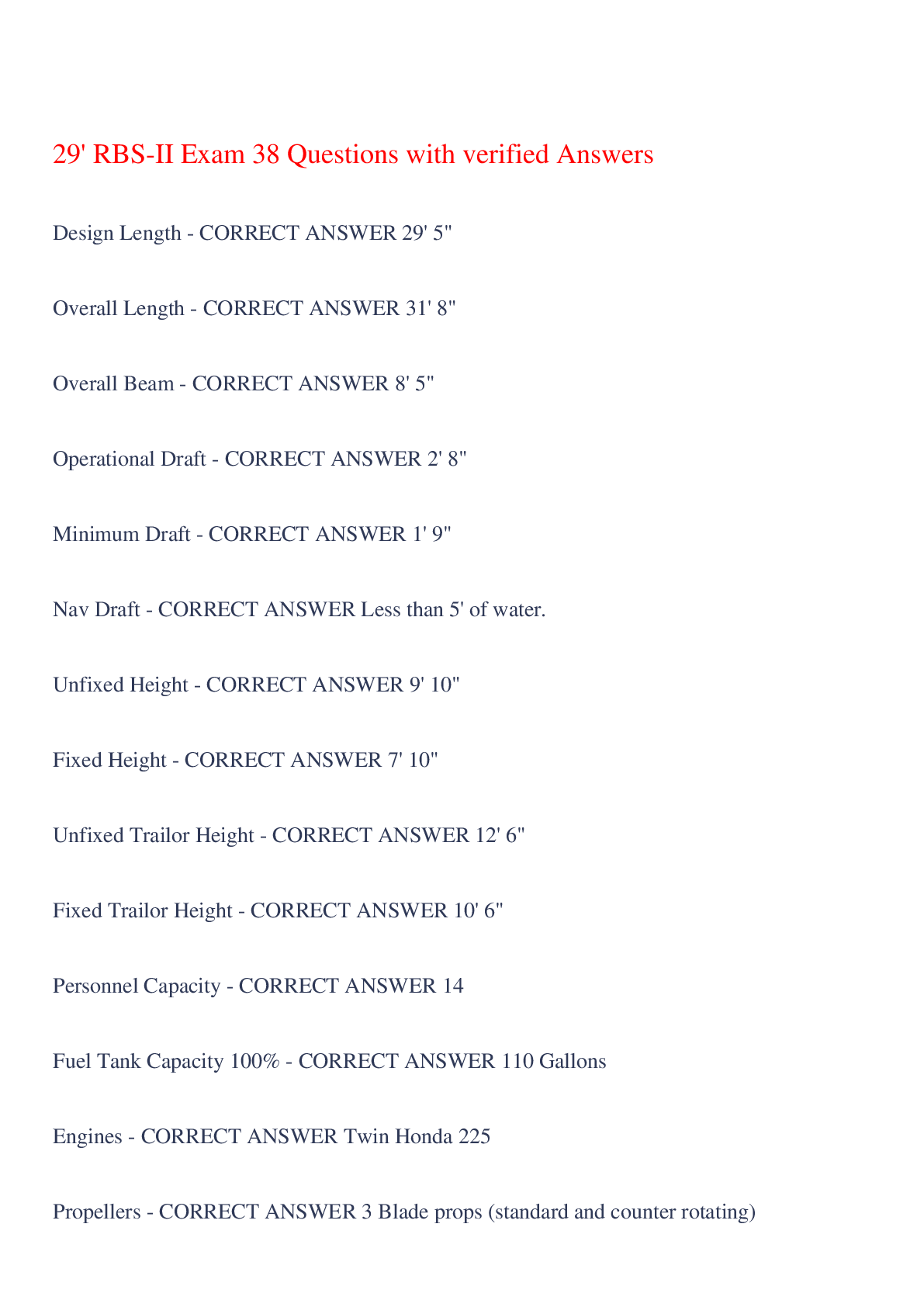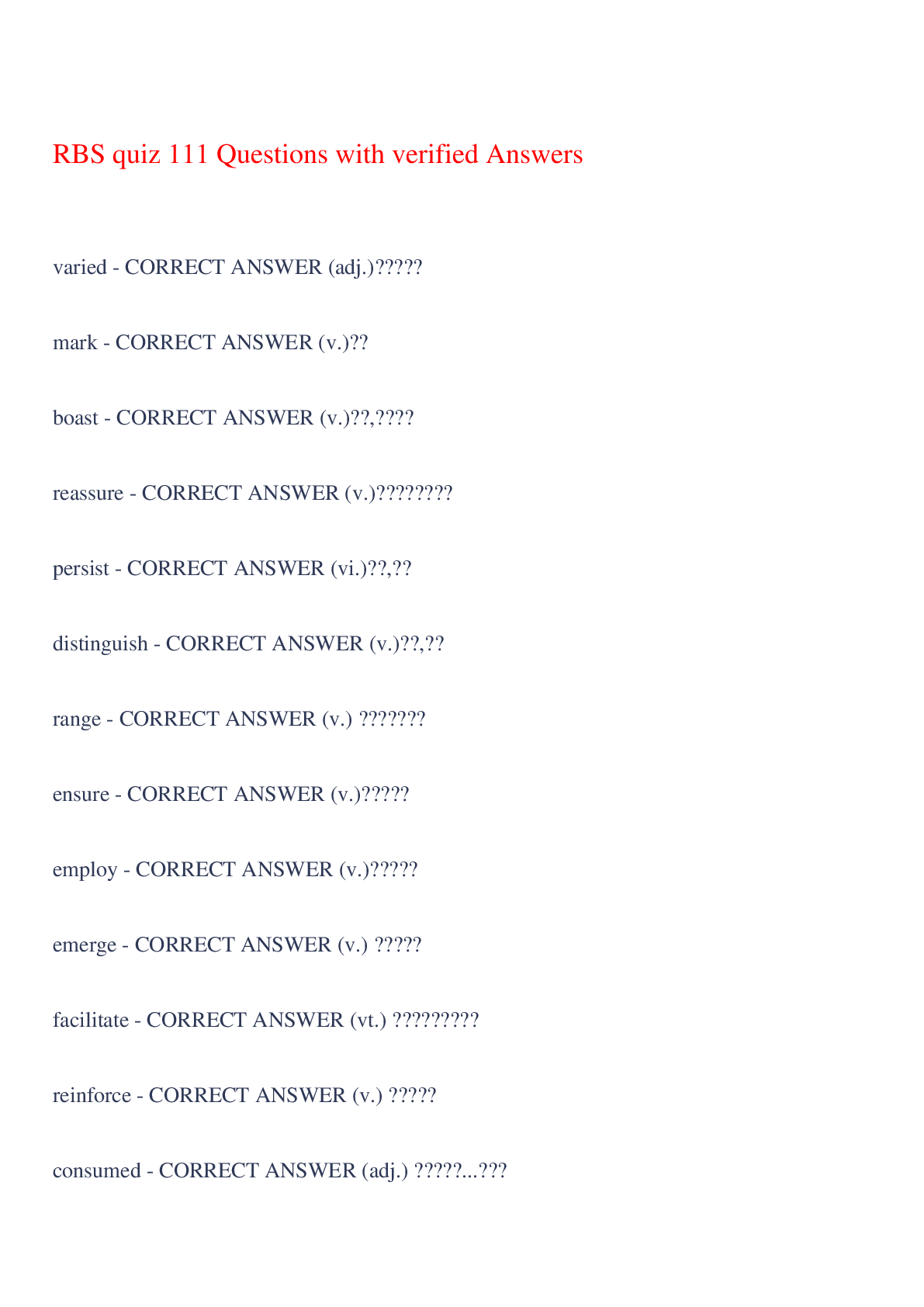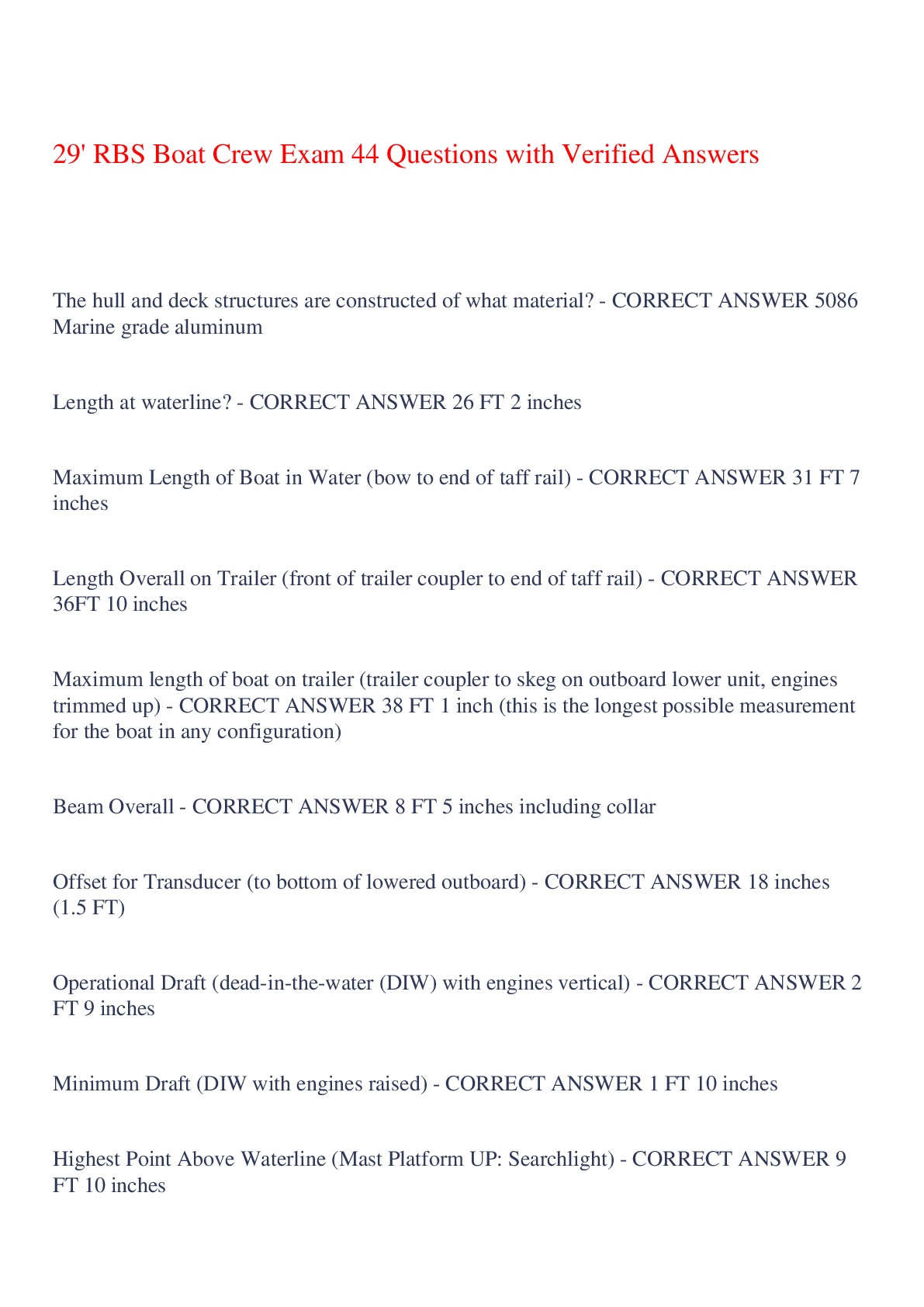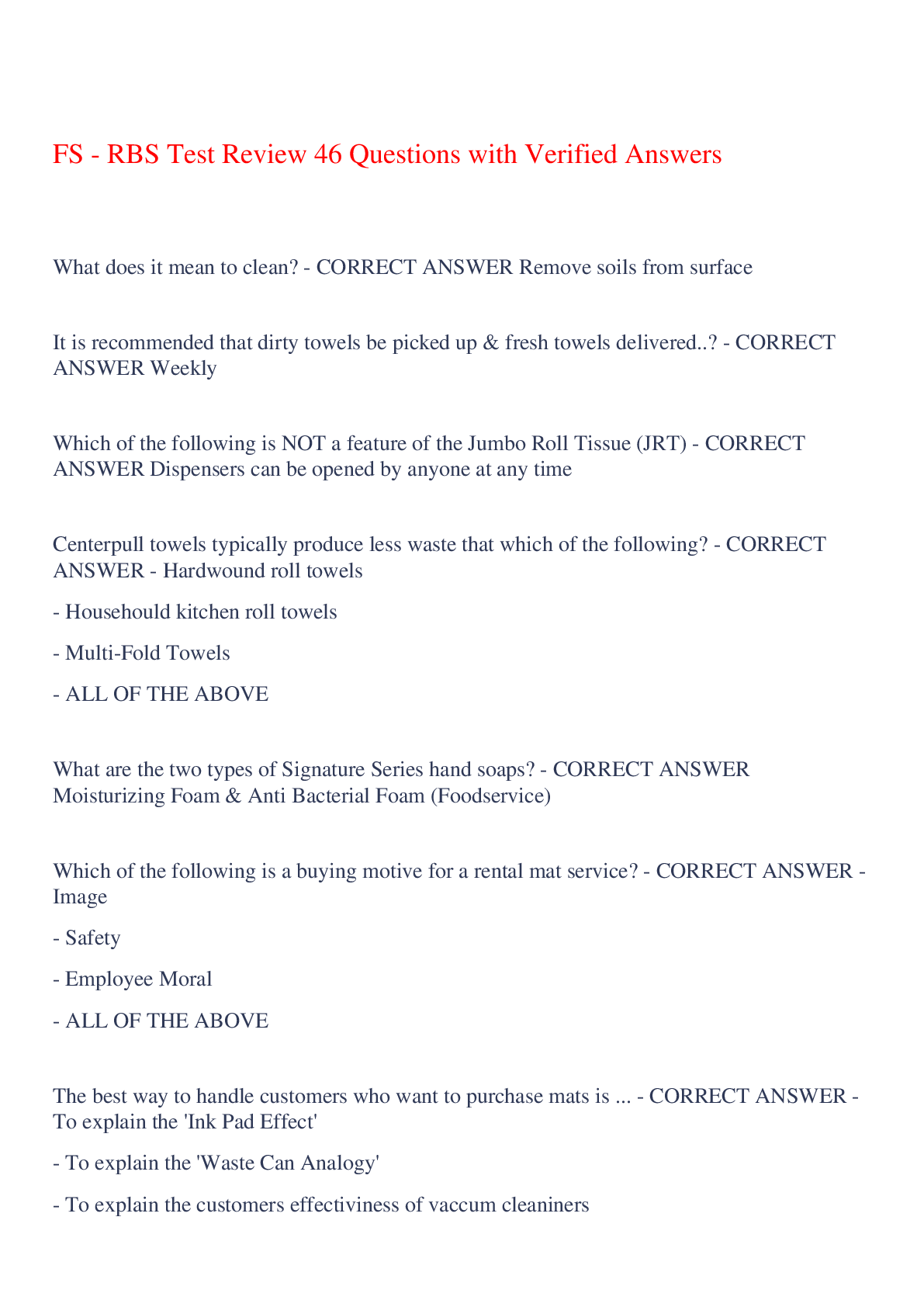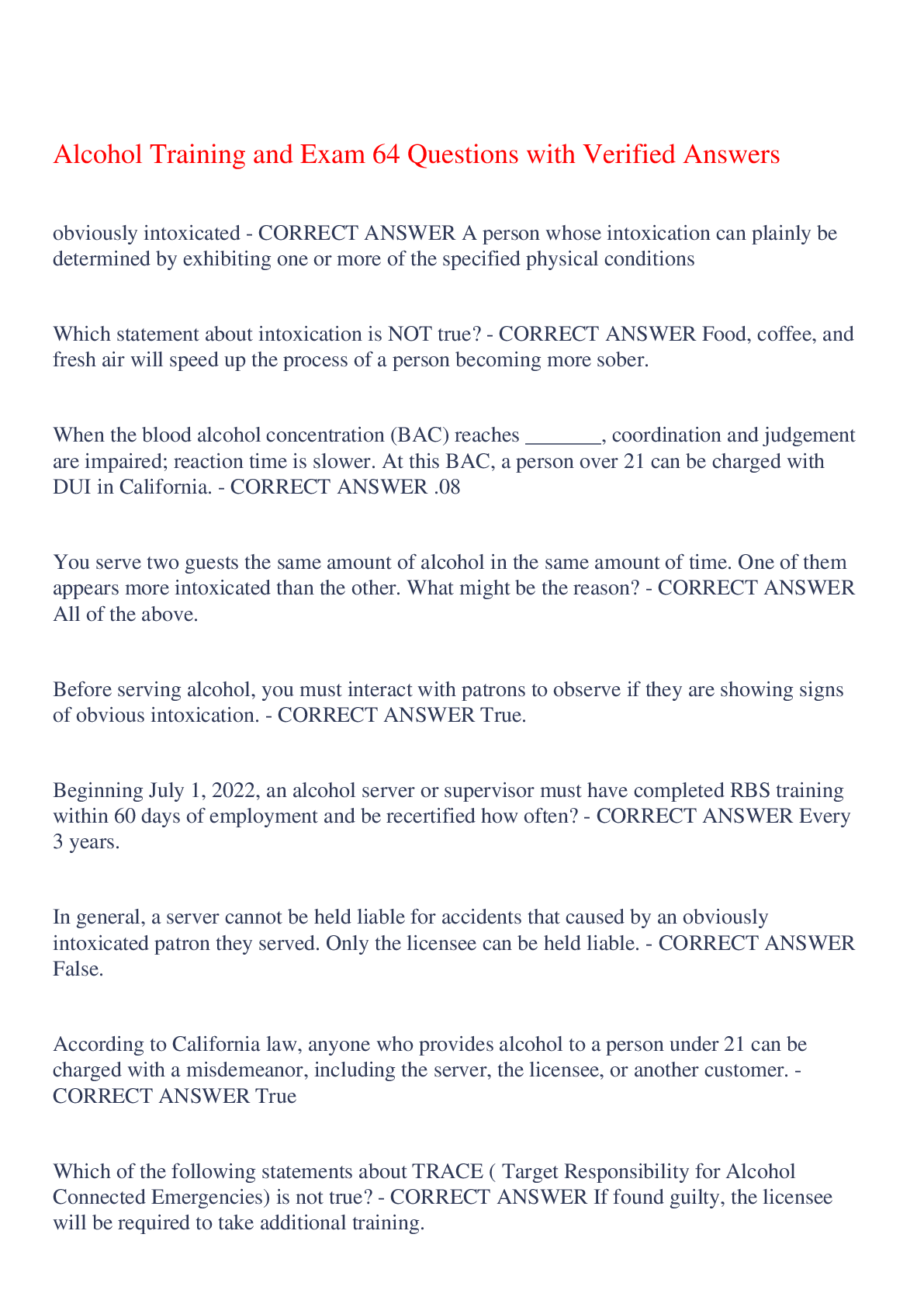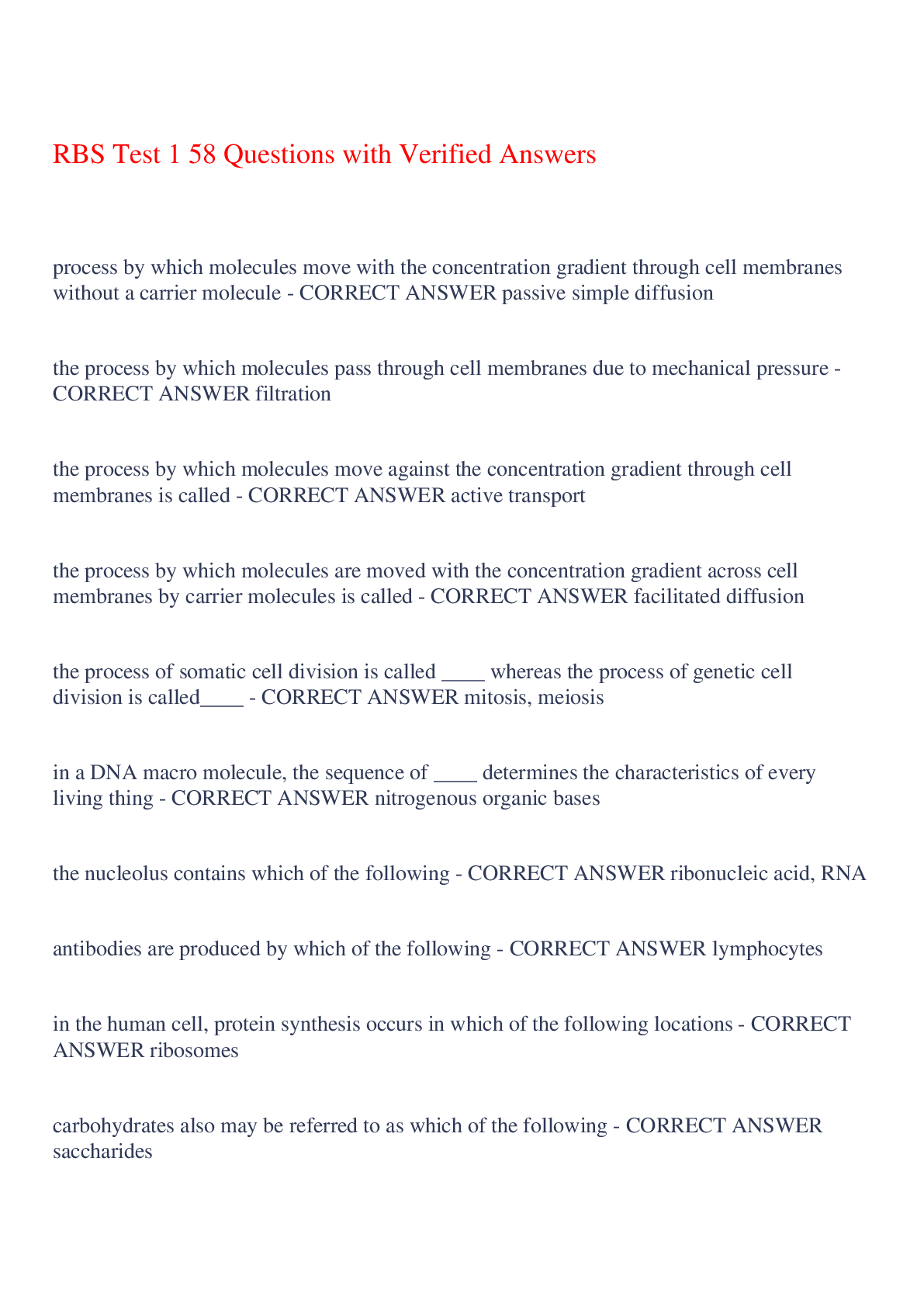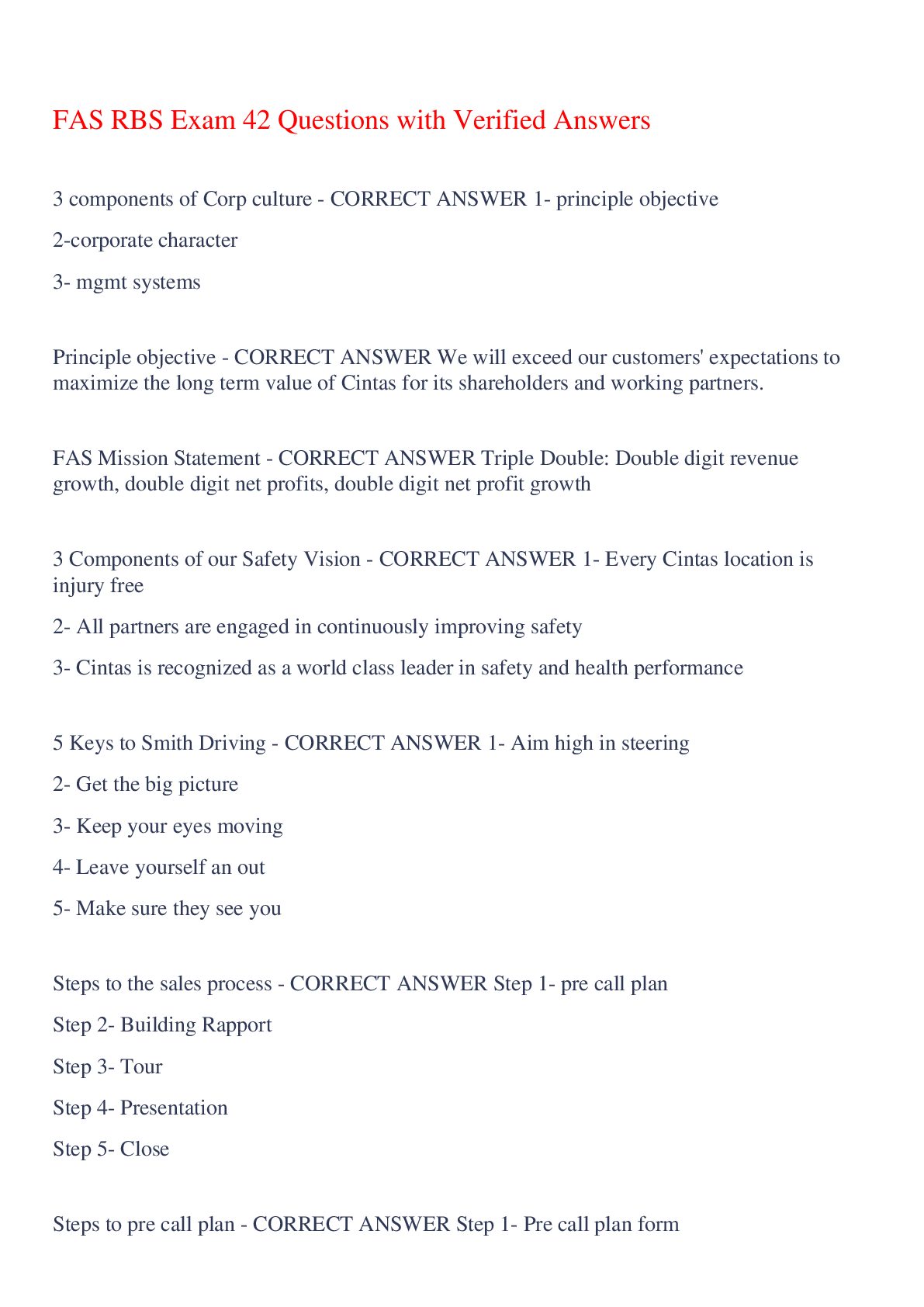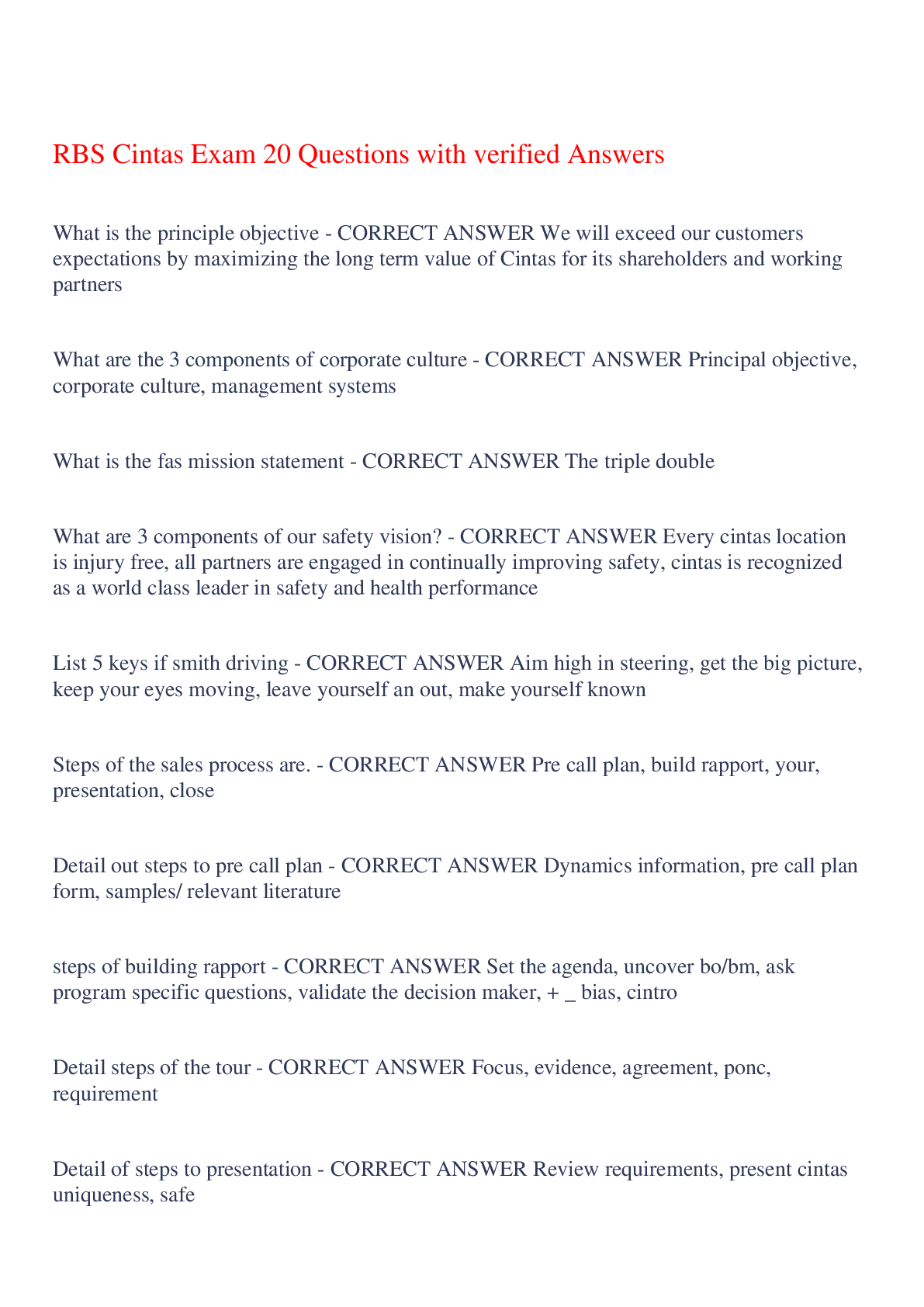CNA Practice 50 Question with Verified Answers,100% CORRECT
Document Content and Description Below
CNA Practice 50 Question with Verified Answers The resident requires ________ precautions for tuberculosis. a. Standard b. Contact c. Droplet d. Airborne - CORRECT ANSWER d. Airborne Tubercu... losis is defined as: a. A viral infection that is similar to the common cold. b. A bacterial infection that affects the lungs. c. A fungal infection that causes inflammation to the liver. d. An antibiotic-resistant infection that is colonized. - CORRECT ANSWER b. A bacterial infection that affects the lungs. While caring for the resident he begins to choke. After calling the nurse and staying with the resident, the nurse aide should: a. Start abdominal thrusts b. Document the findings c. Ask the resident if he can speak or cough. d. Place a fist half way between the resident's rib cage and waist. - CORRECT ANSWER c. Ask the resident if he can speak or cough. Mr. Snyder is 88-years-old. He has tuberculosis, and is disoriented. Mr. Snyder's disorientation means he: a. has decreased cognitive function. b. is alert and oriented. c. paralyzed on one side of the body. d. requires droplet precautions. - CORRECT ANSWER a. has decreased cognitive function. The resident asks the nurse aide to view the facility's survey results. The best response by the nurse aide is: a. "You don't need to look at that right now." b. "Why do you want to see that? You won't understand what you're reading." c. "Those results can be seen after you sign a release to view them." d. "Do you have a specific question I can answer for you?" - CORRECT ANSWER d. "Do you have a specific question I can answer for you?" The resident states his daughter is only mean to him when he asks too many questions. This is an example of: a. Rationalization b. Displacement c. Denial d. Misappropriation - CORRECT ANSWER a. Rationalization Which vital sign should be reported to the licensed nurse immediately? a. Blood pressure 138/88 mmHg b. Respiratory rate 28 breaths per minute c. Oral temperature 99.1 F d. Pulse rate 99 bpm - CORRECT ANSWER b. Respiratory rate 28 breaths per minute When checking the resident's pulse rate, the Nurse Aide will observe the _____. a. rate, regularity, sound b. rhythm, sound, force c. rate, rhythm, force d. rate, rhythm, characteristics - CORRECT ANSWER c. rate, rhythm, force Maintaining proper body alignment while the resident is lying in bed will help to: a. prevent contractures. b. restrain the resident. c. decrease risk of falling. d. stop blood clots from forming. - CORRECT ANSWER a. prevent contractures When transferring the resident from the bed to the chair, all actions are appropriate EXCEPT: a. place non-skid footwear on the resident. b. place the resident in lateral position. c. place the bed in the lowest position. d. position the chair to the resident's unaffected side. - CORRECT ANSWER b. place the resident in lateral position. When caring for the resident with C-diff, the nurse aide should remember to: a. use sanitizing gel to hand hygiene before and after resident contact. b. use airborne precautions before entering the resident's room. c. only use standard precautions when caring for the resident. d. hand hygiene using soap and water. - CORRECT ANSWER d. hand hygiene using soap and water. The resident who is bed-bound should be repositioned every: a. 30 minutes b. Hour c. 2 hours d. Day - CORRECT ANSWER c. 2 hours The resident who needs assistance with eating should be placed in the ____ position. a. supine b. lateral c. prone d. Semi-Fowler's - CORRECT ANSWER d. Semi-Fowler's In the chain of infection link, the ____ describes the person who could become infected. a. mode of transmission b. portal of exit c. susceptible host d. causative agent - CORRECT ANSWER c. susceptible host The resident was recently found to have pediculosis. This will require _____ precautions. a. airborne b. contact c. droplet d. standard - CORRECT ANSWER b. contact The resident needs a breathing treatment. Which member of the health care team will assist? a. Respiratory therapist b. Speech therapist c. Occupational therapist d. Social worker - CORRECT ANSWER a. Respiratory therapist The nurse aide is allowed to perform which action? a. Pause an alarming IV pump. b. Rub medicated ointment on the resident's skin. c. Remove a nasogastric tube. d. Observe the resident for signs of infection. - CORRECT ANSWER d. Observe the resident for signs of infection. All of the following are risk factors for falls EXCEPT: a. medication b. gait problems c. urinary frequency d. non-skid footwear - CORRECT ANSWER d. non-skid footwear Which resident has a higher risk for choking? a. The resident who is alert and oriented. b. The resident with cognitive impairment. c. The resident who swallows without difficulty. d. The resident who ambulates without assistance. - CORRECT ANSWER b. The resident with cognitive impairment. The best way to prevent the spread of infection is: a. following precaution guidelines. b. performing hand hygiene. c. using standard precautions. d. wearing gloves. - CORRECT ANSWER b. performing hand hygiene. When assisting the resident with a bed bath, the nurse aide should: a. gather supplies after raising the bed to working height. b. remove all clothing and linen before starting the procedure. c. observe the resident's skin for bruises, rashes, and open areas. d. transport the resident to the shower using a trolley lift. - CORRECT ANSWER c. observe the resident's skin for bruises, rashes, and open areas Which action is appropriate when assisting the resident with bed bath and perineal care? a. Cleanse legs and feet first, then chest and arms b. Change bath water and gloves after washing legs and feet. c. Avoid washing the perineum area d. Wipe the perineum area from back to front. - CORRECT ANSWER b. Change bath water and gloves after washing legs and feet. The best position for reducing pressure on one side of the body is: a. supine b. Fowler's c. Semi-Fowler's d. lateral - CORRECT ANSWER d. lateral The resident's head of bed is elevated 38 degrees. The resident is in the ______ position. a. semi-Fowler's b. fowler's c. supine d. lateral - CORRECT ANSWER a. semi-Fowler's The nurse aide is using proper body mechanics if he: a. Pivots the client from one surface to another. b. lifts and twist at the same time during resident transfer. c. bend at the waist to assist the resident to stand. d. assist the resident to transfer with feet as close together as possible. - CORRECT ANSWER a. Pivots the client from one surface to another. To measure the height for the resident who cannot get out bed and who lays flat, the Nurse Aide will : a. position resident supine and measure from top of head to bottom of feet. b. position resident lateral and measure from top of heat to bottom of feet. c. measure along the curves of the spine. d. use the mechanical lift to position resident on the standing scale. - CORRECT ANSWER a. position resident supine and measure from top of head to bottom of feet. The nurse aide will use a _____ to measure the height of a resident who is bed-bound. a. ruler b. abduction pillow c. tape measure d. lift - CORRECT ANSWER c. tape measure When transferring the resident from the bed to stretcher, the nurse aide should: a. unlock the bed wheels prior to the transfer. b. undrape the resident during the transfer. c. remove the urethral catheter prior to transfer. d. seek the assistance of one additional co-worker. - CORRECT ANSWER d. seek the assistance of one additional co-worker. The resident laying with head of bed flat is in the ______ position. a. lateral b. supine c. Semi-Fowler's d. Fowler's - CORRECT ANSWER b. supine Which position is best for the resident who has difficulty breathing? a. Fowler's b. supine c. lateral d. None of the above e. All of the above - CORRECT ANSWER a. Fowler's Which device is appropriate to use for the resident with an unsteady gait? a. Abduction pillow b. Knee immobilizer c. Gait belt d. Hydraulic lift - CORRECT ANSWER c. Gait belt When assisting the resident with the walker, the nurse aide should: a. stand slightly behind the resident on the right side. b. place the walker as far from the resident as possible. c. check for dizziness after assisting the resident to stand. d. ask resident to step toward walker with right leg first, then left. - CORRECT ANSWER c. check for dizziness after assisting the resident to stand. Turing the resident without disturbing body alignment is known as: a. logrolling b. transferring c. ambulation d. pivoting - CORRECT ANSWER a. logrolling While assisting the resident with the walker, she begins to fall. The nurse aide should: a. try to break the fall by catching the resident. b. position the resident in lateral position while waiting on the nurse to arrive. c. leave any bleeding areas open until the licensed nurse arrives. d. check if resident is breathing. - CORRECT ANSWER d. check if resident is breathing. A fire occurs while caring for the resident. The nurse aide should: a. lock all doors and close all windows. b. remove residents using the elevators. c. activate the fire alarm. d. remove non-ambulatory residents first - CORRECT ANSWER c. activate the fire alarm. The nurse aide needs to check the resident's blood pressure. She should locate the ____ pulse point. a. apical b. brachial c. carotid d. radial - CORRECT ANSWER b. brachial When weighing the resident, the nurse aide will: a. zero the scale after weighing the resident. b. weigh the resident at different times each day. c. ignore manufacturer's instructions for operating the scale. d. subtract the weight of the wheelchair from the total if applicable. - CORRECT ANSWER d. subtract the weight of the wheelchair from the total if applicable. The resident must receive a special diet. Which member of the health care team will assist? a. Speech Therapist b. Social Worker c. Registered Dietician d. Registered Nurse - CORRECT ANSWER c. Registered Dietician The nurse aide finds the resident crying in her room. Which response is most appropriate? a. "I'll come back when you're feeling better." b. "Don't cry, everything will be okay." c. "Why are you crying now?" d. "Is there something you want to talk about?" - CORRECT ANSWER d. "Is there something you want to talk about?" The licensed nurse has instructed you to check the resident's axillary temperature. To complete this task, you will position the thermometer: a. under the resident's tongue. b. in the resident's ear. c. in the resident's rectum. d. in the resident's underarm. - CORRECT ANSWER d. in the resident's underarm. Which vital sign is affected by the resident's hypertension? a. Blood pressure b. Pulse rate c. Respiratory rate d. Temperature - CORRECT ANSWER a. Blood pressure When assisting the resident to ambulate, all the following equipment may be necessary EXCEPT: a. gait belt b. non-skid footwear c. knee immobilizer d. assistive device - CORRECT ANSWER c. knee immobilizer When performing a procedure that may cause blood splash, the nurse aide should use ____ precautions. a. standard b. contact c. droplet d. airborne - CORRECT ANSWER b. contact Which statement is an example of subjective information? a. "There's a red rash to the resident's left upper arm." b. "The resident's breath smells like alcohol." c. "The resident's heart rate is 88 beats per minute. d. "The resident complains of nausea." - CORRECT ANSWER d. "The resident complains of nausea." Which infectious disease requires droplet precaution? a. Tuberculosis b. Scabies c. Pediculosis d. Influenza - CORRECT ANSWER d. Influenza Which infection disease is characterized by yellow discoloration of the skin (jaundice)? a. Hepatitis b. Scabies c. MRSA d. Tuberculosis - CORRECT ANSWER a. Hepatitis Which infectious disease is characterized by watery diarrhea? a. VRE b. Clostridium difficile c. MRSA d. Pediculosis - CORRECT ANSWER b. Clostridium difficile Which action is appropriate infection control practice? a. Carrying linen by holding against your uniform b. Dragging dirty linen across the floor. c. Performing hand hygiene after touching the resident's side rails. d. Disposing of blood-soiled supplies in the regular trash bag. - CORRECT ANSWER c. Performing hand hygiene after touching the resident's side rails. Which sequence is correct when putting on personal protective equipment (PPE)? a. Gloves, mask, goggles, gown b. Gown, mask, goggles, gloves c. Gown, goggles, mask, gloves d. Gloves, gown, mask, goggles - CORRECT ANSWER b. Gown, mask, goggles, gloves When using a mask, the nurse aide should remember to: a. change the mask if the procedure takes more than 20 minutes. b. remove the mask by grabbing the outside of the mask, then the straps. c. perform hand hygiene before removing the mask. d. leave the mask in place if it becomes soiled or damp. - CORRECT ANSWER c. perform hand hygiene before removing the mask. [Show More]
Last updated: 1 year ago
Preview 1 out of 11 pages
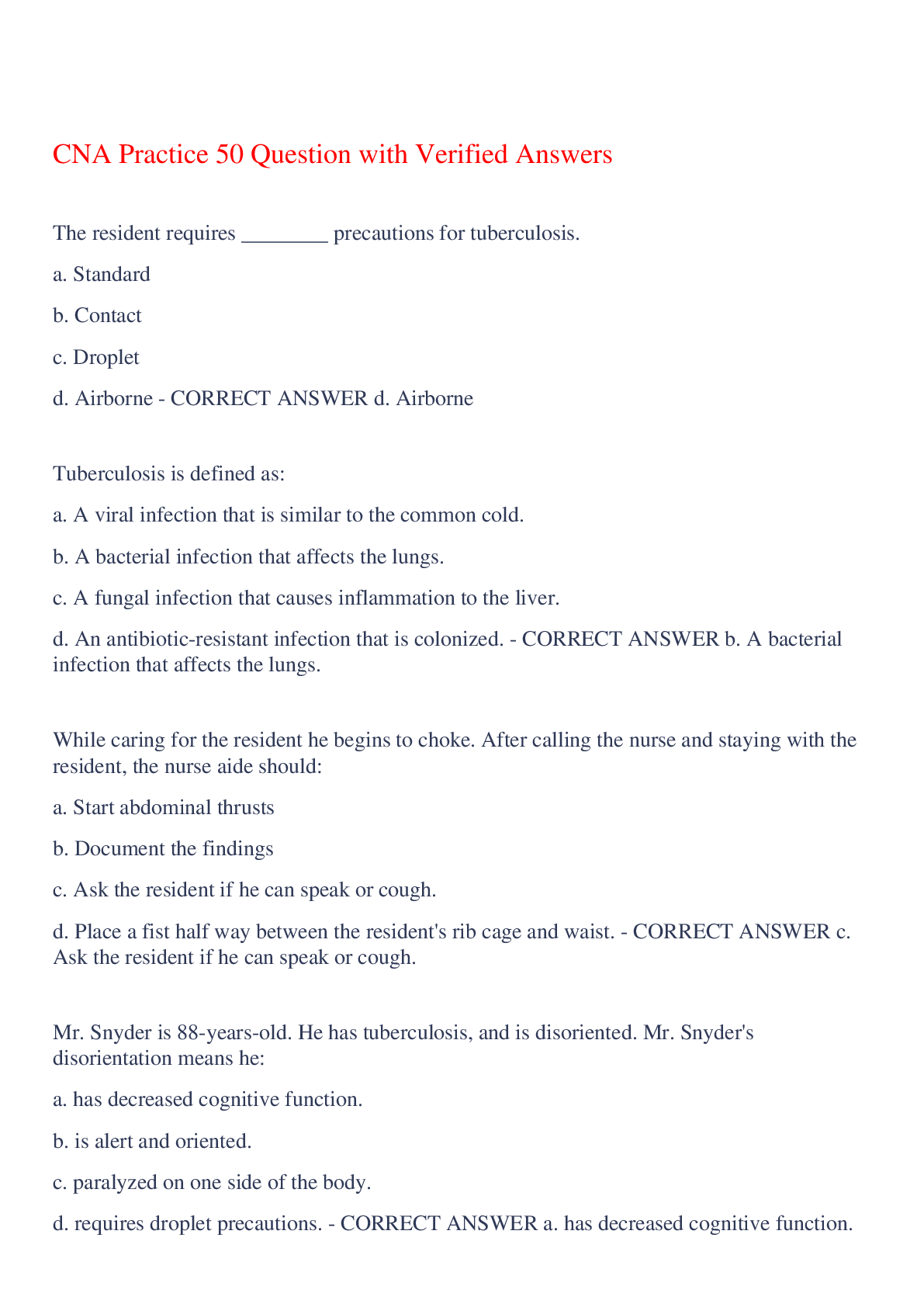
Buy this document to get the full access instantly
Instant Download Access after purchase
Buy NowInstant download
We Accept:

Reviews( 0 )
$8.00
Can't find what you want? Try our AI powered Search
Document information
Connected school, study & course
About the document
Uploaded On
Nov 12, 2023
Number of pages
11
Written in
Additional information
This document has been written for:
Uploaded
Nov 12, 2023
Downloads
0
Views
171


